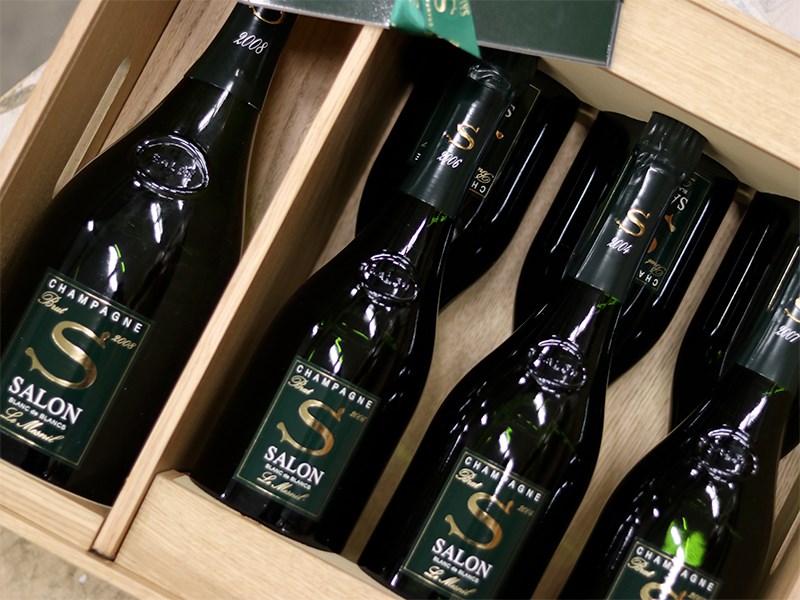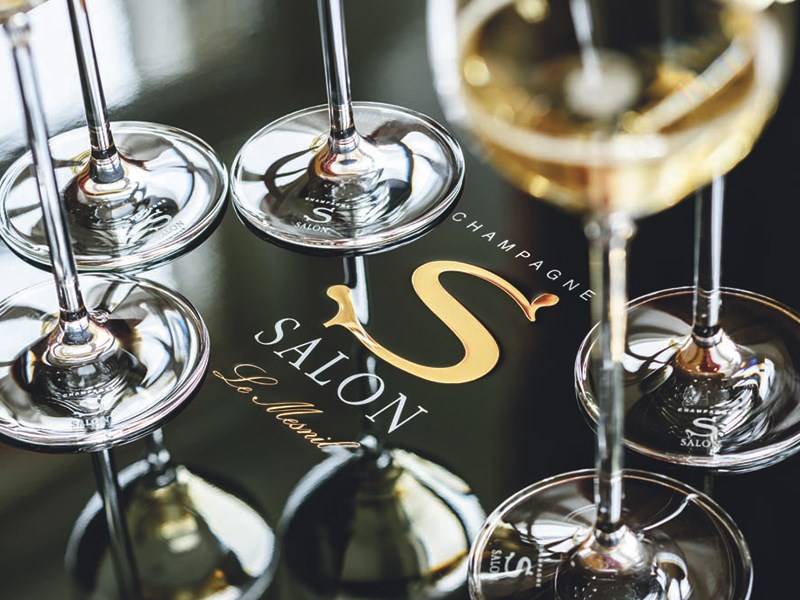Article - RareWine Academy
Salon Champagne Is As Pure As Champagne Can Get
Salon – the name itself can give any Champagne connoisseur goosebumps. Micro-production and sky-high quality offer enormous investment potential.
Exceptional Salon is truly a one of a kind in Champagne. One man, one vision, one grape variety, harvested in one village, made from grapes from one vintage.
Eugène-Aimé Salon has created a wine based exclusively on Chardonnay and with a mission to be uncompromising in terms of quality. All the grapes are harvested in the renowned village of Mesnil-sur-Oger, and the production only counts the vintage Champagne, Salon Cuvée S, which is only released in the vintages that meet the uncompromising quality requirements.
Salon is not just the story of a man and a mission. Salon is the archetype of how to create a unique style and one of the most interesting Champagnes for geeks, romantics, and investors alike. Salon is the example of how the right investors can take the geekery and hype to whole new heights.
The Story Of Salon Champagne
1905 was the year, in which Eugène-Aimé Salon produced his first vintage of Salon Champagne. He was first of all a businessman, but his love for gastronomy and wine gave him the idea. The first vintages he produced were only for his own pleasure and for his guests.
In 1920 Eugène-Aimé Salon founded the house Salon Champagne and started to release the first wines on the market. The first vintages were very small and were only served to his own social circles. As the 1920s became festive in Paris and for the high social classes, to which Engène-Aime belonged, sales started in the best places in Paris too. Maxim's restaurant was the place, where all the right people wanted to see each other. On the best tables, Salon Champagne could be seen as a clear signal that they were on top of the latest trends in the city of cities.
It was a long and tough journey for Eugènie-Aimé Salon to establish Salon Champagne, and it is probably due to his perseverance that Salon is still on the market today. His passion was indeed uncompromising, and for this reason, Salon was only released on the market, when he found the quality satisfactory. Right up to his death in 1943, Salon was managed in precisely this way.
In the midst of another war, Eugènie-Aimé's sister had to take over the operation of Salon Champagne. These were difficult times for France and the rest of the world. The sister had little interest in the Champagne house but left the daily management to the cellar master. The main sales point until the 1950s remained Maxim's restaurant in Paris. During these years, exports to Europe slowly began, but it was not until 1983 that the first cases were exported across the Atlantic to the United States.
In 1968, Salon Champagne was sold to Dubonet-Cinzano, which has roots in the spirits industry. In this way, they became part of the Pernod-Ricard group for a number of years. It was not the right place to be when the focus was so singularly on high quality and limited quantities of a single product. Then in 1989, the year after the great 1988 vintage, Salon was traded for the last time – perhaps. Champagne house Laurent-Perrier stepped up and acquired Salon. Now, it was time again for an uncompromising qualitative approach to the production.
Salon Is A Piece Of History: The First Blanc De Blancs On The Market
When Eugènie-Aimé Salon started to produce Champagne from pure Chardonnay, he went against an old norm in Champagne. A norm started by Dom Pierre Pérignon himself a few centuries before, blending Pinot Noir into the wine. The style of pure Chardonnay is now known as Blanc de Blanc; white (wine) from white (grapes) and was thus invented by Eugènie-Aimé Salon.
At that time, the general opinion in Champagne was that Pinot Noir or Pinot Meunier should be added to the wine to create the right balance.
Read more about the production of Champagne here: The Art Of Champagne Manufacturing
The Grapes For Salon Come From Famous Mesnil
All the grapes for Salon Champagne come from the village of Mesnil-sur-Oger, which is classified as a Grand Cru for Chardonnay grapes. The village is located in the Côte de Blancs and expresses the optimum for Chardonnay made into sparkling wine. The same village is home to the grapes for many of the very best Champagnes on the market, including the vineyard that supplies the grapes for Krug's legendary single vineyard Champagne Clos du Mesnil.
Jardin de Salon both sounds good and is good. Jardin de Salon is the name of a small vineyard that has always provided the backbone of Salon Champagne. The vineyard is just one hectare in size and grows Chardonnay for Salon. The vineyard was planted back in 1905 but was unfortunately replanted in 2002 due to disease that destroyed the old vines. Today, Salon Champagne is made from grapes grown in this vineyard and 19 other vineyards in Mesnil-sur-Oger. Originally, 20 small growers supplied grapes to Salon, but in 1971, Krug Champagne acquired the single vineyard Clos du Mesnil, which no longer supplies grapes to Salon. The families of the remaining 19 growers all worked with Eugène-Aimé Salon in the early 20th century.

Today's Salon Champagne
From the beginning, Laurent-Perrier has intended to maintain the unique position Salon has created in the market. Until 2000, only 37 vintages of Salon Champagne were released. With constant consumption, this means that there are very few mature bottles available on the market to satisfy the huge demand. This is particularly interesting if you look at Champagne from a speculative perspective.
The next vintage to be released will be the 2012, which is the sixth since the turn of the millennium. With a total production of 60,000 bottles in a normal vintage, there are not many bottles on the market for the international and highly demanding public.
Today, Salon Champagne is operated together with the sister house Delamotte, which gets grapes and wine from the unreleased vintages. The two houses are managed by Didier Depond and cellar master Michel Fauconnet, who is also cellar master at Laurent-Perrier.
As a note of interest, the now legendary 2008 vintage stood out right from the start, with perfect balance and high acidity. It is undoubtedly a wine for future generations. For this reason, only magnum bottles were chosen, which is optimal for the development of Champagne. Only 8,000 magnum bottles were bottled, so it is certainly the rarest Salon in recent times – and it exists only in magnum, which in itself makes it extremely attractive as an investment.

Production Methods And Lack Of Cellar Work At Salon
Cellar work often plays a major role in the production of Champagne. It is here that the cellar master has the opportunity to show all his or her talents. This is a major factor in creating many of the styles we know today in other great Champagne houses. Just think of the barrel ageing at Bollinger or the blending of more than 100 wines at Krug.
At Salon, traditions in the area are once again broken. Only one wine is made here – the Cuvée S, whereas little influence as possible is given to the raw materials that come in from the vineyard.
All grapes are harvested by hand and pressed immediately. Fermentation takes place in steel tanks, which has been the case since the 1970s. This preserves all the qualities of the grapes for the final wine. The wine is blocked so that it does not undergo malolactic conversion, thereby preserving the naturally occurring malic acid in the wine. This gives more richness, higher acidity, and longer storage potential. It also means that the wine may be less approachable when young, but the potential for development is enormous.
The wine from Jardin de Salon is blended with the parcels acquired from old contracts in the village. Each parcel of old grapes delivers a stable high quality. Only the best is blended and bottled for this vintage's expression of Salon Champagne Cuvée S. Then the bottles are put in the cellar for the classic second fermentation in the bottle.
Before disgorging, Salon is cellared for between 8 and 12 years to add the extra complexity that comes from aging with sediment in the bottle. The ageing time is determined by the cellar master according to the taste. No vintage is disgorged at more than 8 grams per litre, as the aim is to preserve the structure of the wine.
After disgorging, the Champagne stays in the cellar for a few more years to settle before being released on the market. No processes are rushed, as they only want to show off the best. At Salon Champagne, history is carefully preserved, and samples of most vintages are still kept in the deep library. These are wines that have a long potential for development and that only get better with the years.
The Best Vintages Of Salon
There is not a bad vintage of Salon Champagne. Only one wine is made, and it is only released in exceptional vintages. That said, there are always diamonds that shine a little brighter than other diamonds. 2008, 2002, 1996, 1988, 1979, 1961 all stand out a little brighter than the other rare "diamonds" that are released every few years.
Even more impressive is the fact that every time one of the old vintages with more than 40 years of age is opened, it gives great tasting experiences to the few who get the chance. It is this impressive storage potential that is helping to increase interest in Salon Champagne among wine investors from around the world, who are also benefiting from the limited production and huge demand. Salon is truly unique and has a huge fan base all over the world.
Also read our story about how Champagne develops: How Long Can Champagne Be Stored?
